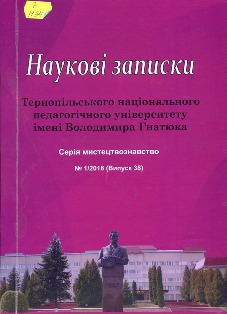ВИКОРИСТАННЯ ПРИНЦИПУ ГРИ ДЛЯ СТВОРЕННЯ РОЗВИВАЮЧОГО АРХІТЕКТУРНО-ХУДОЖНЬОГО СЕРЕДОВИЩА В ЗАКЛАДАХ СОЦІАЛЬНОГО ЗАХИСТУ ДІТЕЙ
Ключові слова:
принцип гри, дизайн, інтер’єр, соціальний захист, психічний розвиток дітейАнотація
У статті розглянуті особливості використання естетичних принципів гри в дизайні інтер’єрів спеціалізованих закладів соціального захисту дітей. Проаналізовано вплив ігрового методу на їх психічний розвиток. Акцентовано увагу на способах створення ігрових емоцій і межах використання ігрового методу в даних інтер’єрах.
Посилання
Barsukova, N. I. (2008), “Design of the environment in the design culture of postmodernism of the end of XX – the beginnings of the XXI centuries”, Thesis abstract for Doc. Sc. (Art Studies), 17.00.06 “Industrial art and design”, Moscow, All Russian Research Institute of Technical Aesthetics, 48 p. (in Russian).
Basyuk, V. S. (2004), “Psychology and pedagogical maintenance as a condition of compensation of mental deprivation condition at orphan children”, The dissertation of the candidate of psychological sciences. Specials 19.00.07 “Pedagogical psychology”, Irkutsk, Irkutsk State Pedagogical University, 208 p. (in Russian).
Bondarchuk, Yu. S. (2016), “The principles of the children’s game environment design in public appointment institutions” The dissertation of the candidate of Art Studies. Specials 17.00.07 “Design”, Kharkiv, Kharkiv State Academy of Design and Arts, 310 p. (in Ukrainian)
Voytishek, E. E. (2010), “Game traditions in mental culture of Japan”, Thesis abstract for Doc. Sc. (History), 07.00.07 “Ethnography, ethnology anthropology”, Novosibirsk, Novosibirsk State University, 49 p. (in Russian).
Gaykazova, R. T. and Kostrikina T. D. (1974), Oformlenie detskikh doshkol’nykh uchrezhdeniy. Znachenie arkhitekturno-prostranstvennoy sredy v vospitanii doshkol’nikov [Decoration of preschool institutions. Meaning of the architectural and spatial environment in education of preschool children], Moscow, Prosveshchenie. (in Russian).
Zherdev, E. V. (2002), “Metaphor in design: theory and practice”, The dissertation of the doctor of Art Studies. Specials 17.00.06 “Industrial art and design”, Moscow, (All Russian Research Institute of Technical Aesthetics), 253 p. (in Russian).
Karavatska, N. O. (2009), Esthetic regularities of a game method in modern design, Aktualni filosofski ta kulturolohichni problemy suchasnosti: Zb. nauk. prats [Actual philosophy and cultorial problems of the present: Scientific collected works], vol. 23, pp. 214–220. (in Ukrainian).
Novoselova, S. L. (2004) Sistema «Modul’ – igra». Novaya razvivayushchaya predmetnoigrovaya sreda dlya doshkol’nikov i pedagogicheskaya tekhnologiya ee ispol’zovaniya [Module – Game system. The new developing subject-game environment for preschool children and pedagogical technology of it use], Moscow, OOF «Sotsial’noe razvitie Rossii». (in Russian).
Nuretdinova, L. G. (2001), “Humanization of orphanage’s educational space” The dissertation of the candidate of pedagogical sciences. Specials 13.00.01 “General pedagogics, History of pedagogics and education”, Kazan, Kazan State Pedagogical University, 200 p. (in Russian).
Oliinyk, O. P., Hnatiuk, L. R. and Cherniavskyi, V. H. (2011), Osnovy dyzainu interieriu: navchalnyi posibnyk [Interior design bases: tutorial], Kyiv, National Aviation University. (in Ukrainian).
Khaliullina, O. R. (2011), “Gender factor in design of the subject environment” Thesis abstract for Cand. Sc. (Art Studies), 17.00.06 “Industrial art and design”, Moscow, (All Russian Research Institute of Technical Aesthetics), 23 p. (in Russian).
Kheyzinga, Y. (1997), Homo Ludens: stat’i po istorii kul’tury [Homo Ludens: articles on cultural history], Moscow, Progress-Traditsiya. (in Russian).
Shubovych, S. O. (2009), Teoriia hry v arkhitekturi (lektsii dlia studentiv 6 kursu dennoi formy navchannia spets. 7.120102, 8.120102 – Mistobuduvannia) [Play theory in architecture (lectures for students of 6 year day studies)], Kharkiv, O. Beketov National University of Urban Economy in Kharkiv. (in Ukrainian).

